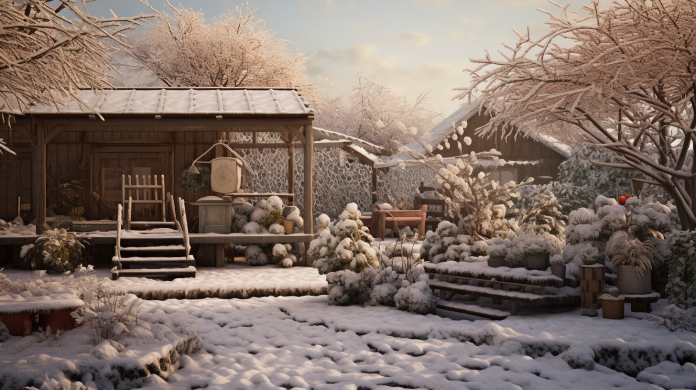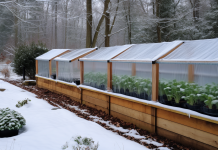Welcome to ‘Gardening by the Fireplace: Expert Tips for Cozy Winter Gardens.'
As the frosty season approaches, it's time to transform your garden into a warm and inviting sanctuary. In this article, we will provide you with insights on:
- Selecting the right plants
- Maximizing sunlight and heat
- Protecting your greenery from frost
- Creating a cozy outdoor space
Additionally, we'll share essential maintenance tips to ensure your winter garden thrives in the chilly months ahead.
Choosing the Right Plants for Your Winter Garden
Selecting the appropriate plants for your winter garden requires careful consideration of their cold tolerance and ability to thrive in low light conditions.
When it comes to plant selection for winter gardening, it is essential to choose varieties that can withstand freezing temperatures and limited sunlight. One of the key winter gardening techniques is to opt for plants that are known for their cold hardiness. These include evergreen shrubs, such as holly and boxwood, which retain their leaves throughout the winter months.
Other suitable options are winter-flowering plants like pansies, cyclamen, and winter jasmine, which add a splash of color to your garden during the colder months.
Additionally, cold-season vegetables like kale, chard, and Brussels sprouts can be grown in winter gardens, providing fresh produce even in low light conditions.
Maximizing Sunlight and Heat in Your Garden
To ensure optimal growth and warmth in your winter garden, positioning and utilizing sunlight and heat are crucial considerations.
Maximizing insulation and making the most of available sunlight can greatly enhance the overall aesthetics of your winter garden. When it comes to positioning, it is important to choose an area that receives maximum sunlight during the day. This can be achieved by selecting a location that is not obstructed by trees or buildings.
Additionally, using reflective materials such as mirrors or white surfaces can help redirect and amplify sunlight in your garden.
Furthermore, incorporating elements like mulch and cold frames can help maximize insulation and retain heat, creating a more conducive environment for your plants.
Protecting Your Plants From Frost and Cold
Implementing proper frost protection measures is essential for safeguarding your plants from the frigid temperatures of winter. Insulating techniques for winter plant protection play a crucial role in ensuring the survival and health of your garden.
One effective method is to cover your plants with blankets or burlap sacks, providing an additional layer of insulation. These materials trap heat and create a barrier against the cold.
Another innovative frost prevention method for plants is using frost cloths or frost blankets. These specially designed covers allow light and air to pass through while protecting your plants from freezing temperatures.
Additionally, consider using mulch to insulate the soil and protect the roots of your plants. Apply a thick layer of organic material around the base of each plant to provide insulation and prevent frost damage.
Creating a Cozy and Inviting Outdoor Space
Electric power out to the garden is almost an essential. From the plant heat mat in the greenhouse or polytunnel to lighting for the long evenings to heating for the cold nights there are not many viable alternatives to electric power for winter months.
You can enhance the ambiance of your outdoor space with warm lighting and comfortable seating. Create an inviting atmosphere for enjoying your winter garden. Adding string lights or lanterns can provide a warm and inviting glow, while waterproof blankets and cushions can make your seating area more comfortable. You could also consider incorporating the essential fire pit or outdoor fireplace for added warmth and ambiance. Additionally, adding some personal touches like outdoor artwork or unique planters can help create a welcoming and cozy atmosphere in your winter garden. With a little creativity and some DIY projects, you can transform your outdoor space into a haven for enjoying the beauty of your winter garden.
Essential Winter Garden Maintenance Tips
During the winter season, it is crucial to prioritize essential maintenance tasks in your garden to ensure its health and vitality. Here are three important winter garden maintenance tips to keep in mind:
- Winter garden watering: While it may seem counterintuitive, (subject to your zone or local conditions) it may be necessary to water your garden during the winter months. Although plants may not require as much water as they do in the warmer seasons, it is essential to provide them with enough moisture to prevent dehydration and ensure their survival.
- Winter garden pest control: Pests can still pose a threat to your garden during the winter. Take precautions by regularly inspecting plants for signs of pest infestations and applying appropriate pest control measures. This will help protect your plants from damage and ensure their overall health.
- Pruning and trimming: Winter is an ideal time to prune and trim most plants. Remove any damaged or dead branches to promote new growth and maintain the overall shape and structure of your garden. This will also help prevent the spread of diseases and pests.
Key Takeaways
- Stay Inside, read some gardening books 🙂
- Choose plants that are cold-tolerant and can thrive in low light conditions
- Position plants in an area that receives maximum sunlight to maximize warmth
- Implement proper frost protection measures to protect plants from cold temperatures
- Create a cozy and inviting outdoor space with warm lighting, comfortable seating, and unique decor
- Don't forget the firepit
Conclusion
In conclusion, creating an inviting outdoor space during winter can be achieved by:
- Carefully selecting the right plants
- Locating them in an area of maximized sunlight and heat
- Protecting the plants from frost and cold
- Having a fire pit or similar nearby
Remember, maintenance is essential to ensure the health and vitality of your winter garden and has knock-on effect into your Spring garden.
Enjoy a beautiful and thriving garden even during the colder months.
To Be Honest there is a lot to be said to taking a few months off from the garden at this juncture.
Please see our supporting article:
Expert Tips for Planting Autumn Bulbs for Spring Beauty



